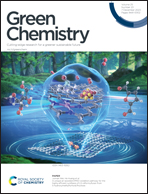Bio-glycerol hydrodeoxygenation to propylene: advancing knowledge on Mo-based catalyst characteristics and reaction pathways under flow conditions
Abstract
In this work, the reaction pathways of one-step glycerol hydrodeoxygenation in the gas phase are exploited under flow conditions over molybdena-based catalysts (8.7 wt% Mo/black carbon). Hydrodeoxygenation (HDO) experiments with possible reaction intermediates along with temperature-programmed surface reaction spectroscopy (TPSR) experiments demonstrated two possible reaction pathways. The major one involves propylene formation via hydrodeoxygenation of 2-propen-1-ol which is considered to be the main intermediate of the reaction. In the secondary route, propanal formed via 2-propen-1-ol isomerization is further converted to 1-propanol. XPS measurements in fresh-reduced and reduced-used catalysts revealed that molybdena exists as multivalent species mostly as Mo5+, Mo4+ and Mo3+, the presence of which seems to be crucial for the desired pathway of successive HDOs towards propylene. TPSR tests using methanol as the probe molecule showed that redox and acid sites co-exist on the surface of reduced molybdena catalysts, and this bifunctionality is mostly served by the undercoordinated molybdena species. The long-term catalyst test at 280 °C and 60 bar pressure under glycerol hydrodeoxygenation conditions demonstrated that the catalyst remains stable in terms of activity and selectivity for the first 10 h with a gradual drop afterwards. Regeneration of the catalyst for a short time under hydrogen flow proved to be sufficient to fully recover the initial activity and product selectivity.



 Please wait while we load your content...
Please wait while we load your content...